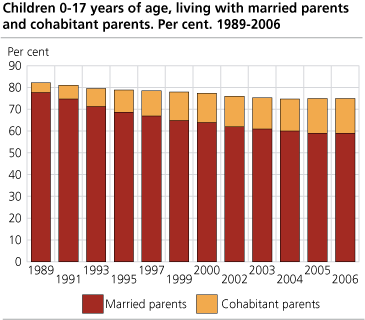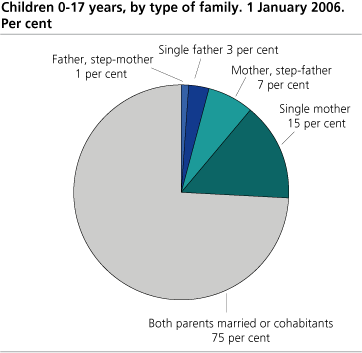Content
Published:
This is an archived release.
Fewer children live with both parents
The percentage of children living with both parents is gradually decreasing in Norway. In 1989, the first year Statistics Norway published child statistics, 82 per cent of the children aged 0-17 years lived with both their parents. Per 1 January 2006 this percentage was down to 75.
In the same period of time, the percentage of children living with both parents married, dropped with 19 percentage points, from 78 to 59 percent. This has partially been compensated for by the fact that it is now more common to live with cohabitating parents. Per 1 January 2006 16 per cent of all children lived with cohabitating parents. In 1989 the corresponding percentage was 5.
In total, 808 100 children in Norway lived with both parents by 1 January 2006.
274 600 children, or a little more than 25 per cent of all children aged 0-17 years lived with only one parent. Of these 86 per cent, or 235 800 children, lived with their mother. Approximately one third of the children living only with one of their parents still live in families with two adults, i.e. they are living with a stepfather or a stepmother.
|
Children are in the child statistics defined as persons 0-17 years old registered as living with at least one of the parents at their legal address. Persons aged 0-17 who are married, who have their own children, or who have moved away from the family home are not included. |
Tables:
- Table 1 Children 0-17 years, by number of parents in the family, the parents' cohabitation arrangements and the child's age. 2001, 2005 and 2006. Per cent (Corrected 28 June 2007)
- Table 2 Children 0-17 years, by number of parents in the family, the parents' cohabitation arrangements, siblings living at home and the child's age. 2001, 2005 and 2006 (Corrected 28 June 2007)
- Table 3 Children 0-17 years, by number of parents, the parents' cohabitation arrangements and county. 2001, 2005 and 2006. Per cent (Corrected 28 June 2007)
- Table 4 Children 0-17 år, by type of siblings living at home and the child's age. 2001, 2005 and 2006. Per cent (Corrected 28 June 2007)
- Table 5 Children 0-17 år, by type of siblings living at home and county. 2001, 2005 and 2006. Per cent (Corrected 28 June 2007)
- Table 6 Children 0-17 years, by number of siblings and parents living at home and the parents' cohabitation arrangements. 2001, 2005 and 2006. Per cent (Corrected 28 June 2007)
- Table 7 Children 0-17 years, by number of siblings and county. 2001, 2005 and 2006. Per cent (Corrected 28 June 2007)
- Table 8 Children 0-17 years, by number of siblings and the child's age. 2001, 2005 and 2006. Per cent (Corrected 28 June 2007)
The statistics is published with Families and households.
Contact
-
Statistics Norway's Information Centre
E-mail: informasjon@ssb.no
tel.: (+47) 21 09 46 42


